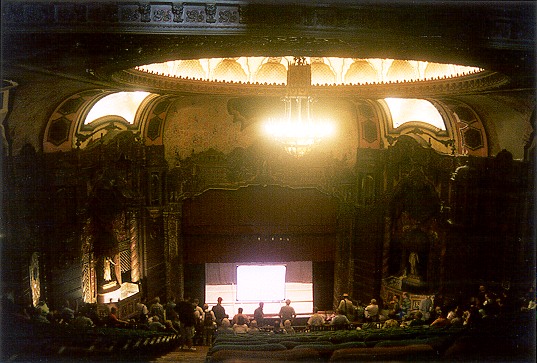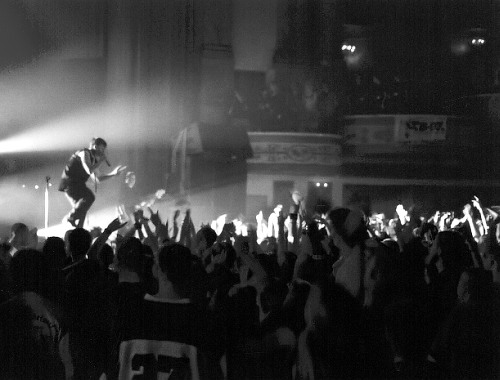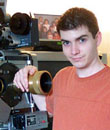|
|
 
|
|
Author
|
Topic: Hello from Calcutta India
|
|
|
|
|
William Hooper
Phenomenal Film Handler
Posts: 1879
From: Mobile, AL USA
Registered: Jun 99
|
 posted 01-27-2005 03:17 AM
posted 01-27-2005 03:17 AM





quote: Daniel Wright
Does anyone have any suggestions on getting photographs.
It depends on what kind of camera you're using. If it's a drugstore single-lens flash camera with no film speed, f-stop, or shutter speed adjustments, you can't be surreptitious, you'll be seen taking snapshots, & the photos will be at the lower end of the what-you-want scale.
Otherwise, 1st get a table-top tripd: it's a little tripod that's about 4" tall. You'll need it for taking long exposures in the funky lighting conditions in theaters. Most of them are adjustable so that you can get the 3 legs close enough together to put the camera on the armrest of a seat. Aiming & balancing are then the next steps.
A lot of digital cameras don't do well with long exposures, you'll have to check yours.
If it's a film camera with adjustments for film speed, a "program" or "auto" mode, & a timed shutter release thing on the front (for putting the camera down & running in front to get in a picture), you can get some very good pictures using a table-top tripod on an armrest out of the box.
The problem in big funky old theatre auditoriums is that they're basically a black hole with ornately decorated walls & (pretty much) one VERY bright light source, a chandelier.

The iris in your eyes adjusts for the light as you look from the chandelier to the walls, but the exposure in a camera takes it all in at the same time & you can't have it all. You'll get either a nice picture of a chandelier in the blackness of space like some huge space anemone menacing the Starship Enterprise (most likely), that's correctly exposed for the chandelier but not the walls; or (very unlikely just in Program or Auto mode) a picture of the walls with an atomic fireball where the chandelier would be, correctly exposed for the walls & other interior parts & overexposed for the chandelier.
You can't have it all, so you usually have to decide which you want; generally the decision is to expose for the walls & overexpose the source of lighting.
The program or auto mode will usually expose for the chandelier, so you need to increase the exposure time to get the walls, etc.
The above picture is a little underexposed for an auditorium picture, but the intent for thant picture was to get the screen onstage. A pretty good guess in those auditorium situations is to expect to need to overexpose 3 stops.
If the camera has a knob to compensate exposure for backlighting, snow, etc. & can be set to +3, use that.
Otherwise, you'll have to fool the camera into thinking you've got slower film, so it will expose longer. You do this by changing the knob which tells the camera the ASA of the film in it (try to MAKE me say ISO, & I'll throw the shell of a parts Kodak XL S8 camera with its f1.0 lens at your head!) If you've got 800 ASA film in the camera, tell the camera that the film is 3 stops slower: 400 ASA is 1 stop slower than 800 ASA, 200 ASA is 2 stops slower, 100 ASA is 3 stops slower. If you do that, remember to set that thing back to what film is really in the camera when you're finished taking pictures in the auditorium!)
Set up your little tripod & use the shutter timer thing to take the picture, so your hand will be off the camera & there will be no camera shake. Hold your hand close behind the viewfinder, so no light will leak in when using the timer.
That's very coarse, & if you're not used to judging lighting conditions & exposures yet, make 3 pictures: one at the exposure above, one exposed for one stop slower still, & one for one stop faster.
A grosser guess is that generally with 800 ASA film in auditoriums like that, the exposure will be 3 to 6 seconds with the aperture wide open on 800 ASA film. But there'll be a lot of difference all along those 3 to 6 seconds, & some bad pictures.
Lobbies, etc. generally have more less extreme lighting conditions & slightly more even lighting, but they're still a bit dark. Compare it to a shot in a theatre like above, & decide if you'll only want 1 or 2 stops overexposed from what "Program" gives you.
You'll do better with print film, which has more latitude than slide film. Fast 1.0 lenses aren't that helpful, because the depth of field is more shallow & at shorter distances you'll get smaller areas that are in sharp focus whicle stuff in front &/or behind will be out of focus.
Two rolls of taking pictures in auditoriums, & you will never again see rooms & light fixtures the same, un-mentally-involved way.
3 stops overexposed from Program is just a rough starting point until you can get better at judging lighting situations, some require less & some require more! It depends on the amount of light, where the light source is located in your picture, how much of the light source is in your picture, how your camera's built-in light meter works (center-weighted, usually), etc.
quote: Dan Lyons
Take them when no one is looking.
Yeah, I'll bet Dan has an interesting collection of pictures.
There's a good overview of the problems of taking pictures in low- & extreme-lighting conditions here. But all due respect to the man, he's concerned mainly with taking pictures of an artist in concert & only wants a head shot. So that's what his equipment recommedndations, etc. are based on.
Your MAMA could take a picture of just a head floating in space with a camera with spot-metering! It's like taking a picture of just a chandelier hanging in space! He's just selling the head shot to an agency or local paper.
If you want more than one thing, you've got to strategize & somehow get a picture that will utilize existing lighting conditions to sufficiently expose more than one thing. Okay, there's somebody in concert, we can tell. Where are they, though? Where's the show? What people are there? No venue, no audience, the damn thing could have been shot in a studio.
It's difficult, but getting all that other stuff is being where you're at.
It's more fun to take pictures of theatres with people in them, than people in theatres.


And remember, even the crappiest picture can be mistaken for something with character if you turn it into black & white:


[ 01-27-2005, 04:47 AM: Message edited by: William Hooper ]
| IP: Logged
|
|
|
|
All times are Central (GMT -6:00)
|
|
Powered by Infopop Corporation
UBB.classicTM
6.3.1.2
The Film-Tech Forums are designed for various members related to the cinema industry to express their opinions, viewpoints and testimonials on various products, services and events based upon speculation, personal knowledge and factual information through use, therefore all views represented here allow no liability upon the publishers of this web site and the owners of said views assume no liability for any ill will resulting from these postings. The posts made here are for educational as well as entertainment purposes and as such anyone viewing this portion of the website must accept these views as statements of the author of that opinion
and agrees to release the authors from any and all liability.
|

 Home
Home
 Products
Products
 Store
Store
 Forum
Forum
 Warehouse
Warehouse
 Contact Us
Contact Us




 Printer-friendly view of this topic
Printer-friendly view of this topic





![[thumbsup]](graemlins/thumbsup.gif)









